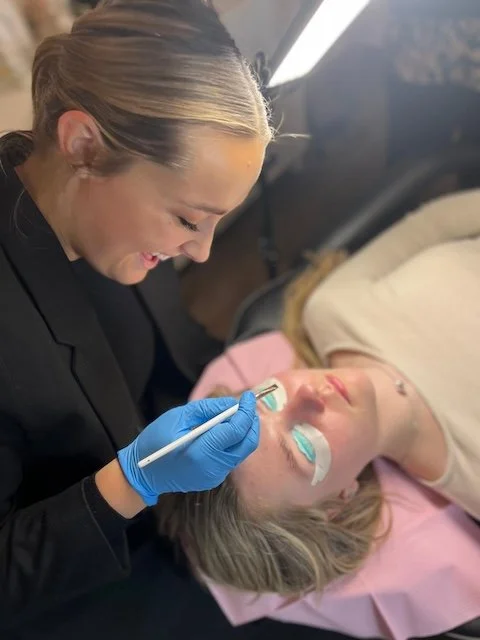Is It Safe to Get a Lash Lift or Tint with Blepharitis?
If you love the idea of easy, low-maintenance lashes but have eye conditions like blepharitis or dry eye syndrome, it’s smart to pause before booking a lift or tint. These semi-permanent treatments use lifting and neutralizing solutions right near your lash line. That can be risky if your eyelids are already sensitive or irritated.
In this blog post, we'll talk about when it’s safe, when to wait, and how to protect your eyes while keeping your lashes healthy and gorgeous.
What is Blepharitis?
Blepharitis is inflammation of the eyelids, often caused by blocked meibomian glands or bacterial buildup along the lash follicles. It can lead to redness, itching, and a gritty, burning sensation.
When you have active inflammation or crusting, your eyes are more sensitive to chemical exposure and beauty products, especially anything used around the lash line.
Learn more in our blog on Blepharitis and Lash Extensions here.
How a Lash Lift and Tint Could Aggravate Blepharitis
A lash lift or lash tint uses a chemical solution to reshape and darken your natural lashes. If you have an eye infection or any irritation, your eyes are already more sensitive. Doing a lift during a flare-up can trigger allergic reactions or make the inflammation worse.
During an eyelash lift, your lashes are gently attached to a silicone rod with glue. Then, a lifting solution (or perming solution) is applied to soften the disulfide bonds in your lashes. This is what lets the hairs reshape into that pretty curl. Finally, a neutralizing solution is added to lock in the lift.
For most people, this process feels comfortable and relaxing. But if you have blepharitis, even small amounts of chemical exposure near inflamed eyelids can cause stinging, redness, or extra sensitivity. The same goes for a lash tint, since the pigment sits so close to your lash line.
Learn more about gentler options like a Keratin Lash Lift here.
How to Get Rid of Blepharitis (and Protect Your Lashes)
If your blepharitis is flaring, wait on your next eyelash lift and focus on your lash care instead:
Apply a warm compress for 5–10 minutes to loosen debris and soothe irritation.
Use a gentle lash cleanser to keep your lash line clean.
Spritz with Hale Derma hypochlorous acid spray after cleansing to help reduce bacteria and support healing.
Skip waterproof mascara, which can be hard to remove and may trap bacteria.
If your symptoms don’t improve after consistent at-home care, it’s best to check in with your eye care professional. They can confirm whether you’re dealing with an infection and, if needed, prescribe medicated drops or ointments to speed up healing.
When to Reschedule Your Appointment
If your eyelids are red, itchy, or flaky, it’s not worth the risk. Wait until symptoms subside and your eye doctor or lash professional gives the all-clear.
A good rule of thumb: if your eyes are uncomfortable without makeup, they won’t tolerate this semi-permanent procedure.
When You're Ready for a Lash Lift and Tint
Once your eyes are healthy again, you can safely enjoy that lifted, dark lash look. A little preparation goes a long way. Here’s how to get lash-ready:
Confirm your blepharitis is fully healed. Your eyelids should be calm, clean, and free from crusting or irritation before treatment.
Try lash growth serums; they support your natural lash follicles without heavy chemical exposure. Read our full guide on How to Grow Long, Healthy Lashes Naturally here.
Book a patch test first. Ask your lash technician to test the lifting and tinting products on your skin to check for any allergic reactions.
Use gentle, hypoallergenic products in your skincare routine to avoid flare-ups before your appointment.
Share your eye history. Let your lash artist know if you’ve had eye infections, cataract surgery, or other eye conditions like dry eye syndrome—they’ll adjust the process for your comfort.
Once you’re symptom-free and prepared, you can book your eyelash lift and lash tint with confidence.
If you’re prone to irritation, explore alternatives like UV LED Lash Extensions here.
Healthy Lashes Start At The Beauty Block
At The Beauty Block, your comfort and eye health come first. Our lash artists take the time to understand your needs, whether you’re healing from blepharitis or just want a safe, beautiful enhancement. We’ll guide you toward the best option for your goals—from subtle lash lifts to full, fluttery extensions.
If you’re searching for a lash lift in Calgary, come visit our welcoming studio at 1409 Edmonton Trl #102, Calgary, AB T2E 3K8. We’re located just minutes north of downtown with convenient parking.
Frequently Asked Questions
Can blepharitis come back after a lash lift?
Blepharitis can come back, especially if oil, makeup, or bacteria build up along your lash line. Keep lashes clean with a gentle lash cleanser and follow good lid hygiene to prevent flare-ups.
What not to do when you have blepharitis?
Avoid rubbing your eyes, wearing waterproof mascara, or using lash serums with harsh ingredients. Don’t schedule treatments like lash lifts, lash tints, or eyelash extensions until symptoms have calmed down. Stick to warm compresses, gentle cleansing, and products made for sensitive eyes.
Who should not get a lash lift and tint?
Avoid these services if you have active eye infections, blepharitis, dry eye syndrome, or recent cataract or laser eye surgery. Those undergoing radiation therapy or using strong topical medications around the eyes should also consult a professional first.


